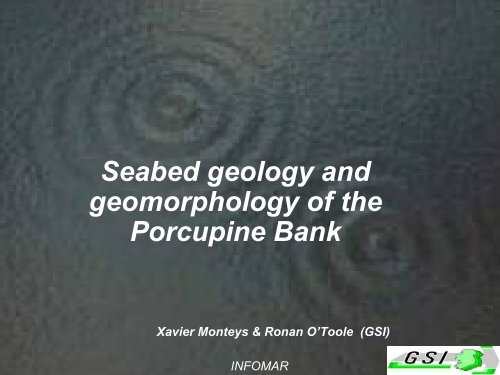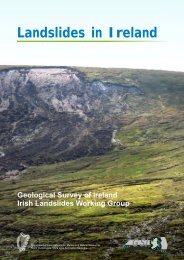New seabed geological map of the Porcupine Bank & seabed ...
New seabed geological map of the Porcupine Bank & seabed ...
New seabed geological map of the Porcupine Bank & seabed ...
Create successful ePaper yourself
Turn your PDF publications into a flip-book with our unique Google optimized e-Paper software.
Seabed geology and<br />
geomorphology <strong>of</strong> <strong>the</strong><br />
<strong>Porcupine</strong> <strong>Bank</strong><br />
Xavier Monteys & Ronan O’Toole (GSI)<br />
INFOMAR
Acknowledgments<br />
• David Hardy & Charise McKeon (GSI)<br />
• Silvia Caloca (GSI)<br />
• Glenn Nolan & MI oceanographic team<br />
• Colm Lordan (MI)<br />
• Eimear O'Keeffe (MI)<br />
• Peter Croker (PAD)<br />
• Anthony Grehan (NUIG)<br />
• Shipboard party <strong>of</strong> a number <strong>of</strong> expeditions from 2000 to 2010
Outline<br />
• Background<br />
– The backbones: INSS, INFOMAR,…<br />
– Large-scale deep-water issues<br />
• Physical <strong>seabed</strong> characterization<br />
– Objectives & Strategy<br />
– Challenges<br />
– Setting<br />
• Results<br />
– Geomorphological <strong>map</strong>s<br />
– Seabed sediment type <strong>map</strong>s<br />
• Discussion & Conclusions
The skeleton<br />
Billions & Billions <strong>of</strong> Deep Echoes<br />
RT<br />
PB<br />
IRELA ND<br />
PR<br />
P<br />
WEST PORCUPINE<br />
P: PORCUPINE BASIN<br />
PB: PORCUPINE BANK<br />
PR: PORCUPINE RIDGE<br />
RT: ROCKALL TROUGH
Goals<br />
Top objective: to develop a comprehensive<br />
Physical Seabed Geo-database for <strong>the</strong><br />
<strong>Porcupine</strong> <strong>Bank</strong> for multidisciplinary<br />
applications.<br />
1. From acoustic properties to <strong>seabed</strong> sed. classes<br />
2. Derive geomorphological features from acoustic<br />
datasets<br />
3. Ground-truth & characterize <strong>the</strong> Geo-database
Data challenges<br />
• Pros:<br />
– Consistency:1 ship, 1<br />
system, short survey time<br />
– Survey Planning<br />
MBES<br />
EM 1002 95 kHz<br />
• Cons:<br />
–System settings (2)<br />
–Different years (2)<br />
–Depth range (scales)<br />
–Scattering domains<br />
–The wea<strong>the</strong>r! (QC)<br />
10-25m<br />
Penetration: 0-~m<br />
SBP<br />
Ocean
Geology<br />
Modified from Haughton et al, 2005<br />
E–W cross section <strong>of</strong> <strong>the</strong> <strong>Porcupine</strong> Basin (modified from Ziegler 1982 & VanRenbsergen 2007 )
Recent environment (~LGM)<br />
After Sejrup et al,. 2005
Seabed<br />
Indurated clay-sand<br />
contourites
Geomorphology
Iceberg Keel marks<br />
Track<br />
7.6Km Long<br />
250-300m wide<br />
10-12m deep<br />
Berms: 1-2m
Overview: Bedrock
Overview: Mounds
Overview:Ridges
Overview: Escarpments
Overview: Iceberg<br />
keelmarks
From <strong>the</strong> raw backscatter data…
…To <strong>the</strong> Seabed Geology<br />
G Cl Lit<br />
ho<br />
Coarse Medium<br />
A 1 sG<br />
2 sG<br />
3 sG<br />
B 4 S<br />
5 S<br />
C 6 mS<br />
fines<br />
7 sM<br />
8 M<br />
9 M<br />
10 M
Seabed geology<br />
G Cl Litho<br />
Coarse Medium<br />
A 1 sG<br />
2 sG<br />
3 sG<br />
B 4 S<br />
5 S
B<br />
C 6 mS<br />
7 sM<br />
fines<br />
8 M<br />
9 M<br />
10 M
Summary<br />
• Seabed and geomorphological <strong>map</strong>s have been produced<br />
and disseminated in a public geodatabase for a range <strong>of</strong><br />
multidisciplinary applications (e.g. site survey, nephrops,…)<br />
• Multiapproach backscatter processing strategy key to obtain<br />
good discrimination between sediment classes and to explore<br />
variability within each class<br />
• Statistical analysis show good correlation patterns between<br />
backscatter levels and sediment properties<br />
– Backscatter analysis discriminates a large number <strong>of</strong> s<strong>of</strong>t fine-grained <strong>seabed</strong><br />
types on <strong>the</strong> slopes, 250-500m (good correlation with % sand)<br />
– But not as good discriminator on hard <strong>seabed</strong>s (and not grain size correlated)<br />
• Interpretation <strong>of</strong> lineaments suggests a more complex glacial history <strong>of</strong> <strong>the</strong><br />
<strong>Bank</strong>
•Future work: <strong>Porcupine</strong> <strong>Bank</strong> expedition in 2011?<br />
After Sejrup et al,. 2005

















